新概念英语第一册第43-44课重点语法
- 格式:docx
- 大小:37.48 KB
- 文档页数:2
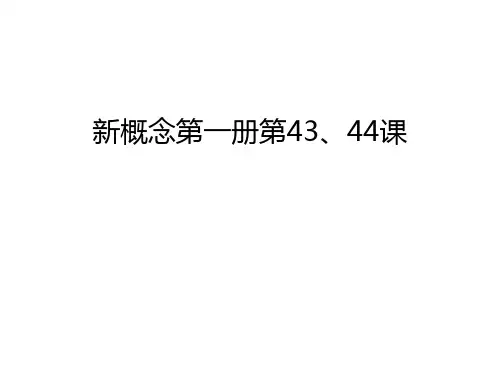
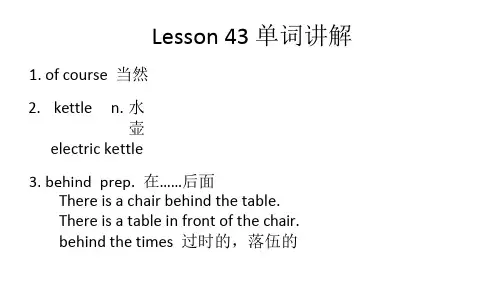
Lesson 43 单词讲解1.of course 当然2.kettle n. 水壶electric kettle3.behind prep. 在……后面There is a chair behind the table.There is a table in front of the chair.behind the times 过时的,落伍的Tom’s cell phone is behind the times.4.teapot n. 茶壶pot 锅,罐,容器hot pot 火锅flowerpot 花盆5.now adv. 现在,此刻--- What are you doing? --- I am cooking now. What are you going to do now?I am busy now.6.find v. 找到7.boil v. 沸腾,开The kettle is boiling.boil v. 煮Please boil me an egg. Please boil an egg for me. oil 油(汽油,食用油) oil painting 油画Lesson 43 课文讲解some & anysome adj. & pron. 一些,若干There is some beer in the bottle.Would you like some?any adj. & pron. 若干,任何Is there any beer in the bottle?No, there isn’t any.There are some books on the table. Are there any books on the table? There aren’t any books on the table. There is some water in the teapot. Is there any water in the teapot? There isn’t any water in the teapot. There are some boys in the room. Are there any boys in the room? There aren’t any boys in the room.如果是一个表示请求、建议、反问的疑问句,或希望得到对方肯定答案才提出的疑问句中可以用some.Shall I have some coffee?What about some tea?Why don’t we have some beer?Are there some students in the classroom?在一个表示部分否定的否定句中可以用some.Some of them are not Chinese.hurry v. 匆忙up adv. & prep. 向上,在高处get uphurry up (quickly)eat upspeed upspeak up (speak loudly) shut upwait up slow downcalm down come down here sit downput that downLesson 43 语法讲解情态动词canmustHe must go now.Must he go now? He needn’t go now. What must he do? We must study English.Must we study English? We needn’t study English. What must we do?She must be in the office.Must she be in the office? She mustn’t be in the office. Where must she be?I can help you.I can’t help you.Can I help you? Who can help you? She can swim.She can’t swim.Can she swim? Who can swim?I can see some clouds in the sky.I can’t see any clouds in the sky. Can you see any clouds in the sky? What can you see in the sky?Can you bring me some water, please? Can I have some water, please?Can I help you?Can I have your name?Can I have your phone number?Can I have your e-mail address?Can I use your bike?Can I have your order?Can I speak to Tom, please?Can I have a look at your cell phone?Can I have the key to the front door, please?Can1.能力Can you swim? I believe I can fly.Can you speak English?Do you speak English?2.允许(征求对方的意见)Can I come in? Can I smoke here?3.请求,要求Can you open the window, please? Can you shut up?Lesson 44 单词句型讲解some & any + 可数名词复数或不可数名词I can write some English letters (字母letter), but I can’t read any English _wo_r_d_s. (单词word)I can make some _tea (茶), but I can’t make any _c_offee. (咖啡)I can eat some _e_g gs_ (鸡蛋),but I can’t drink any bee_r. (啤酒)Lesson 43&44 知识拓展(学生版)1.(2008 北京) ---- you speak Japanese?---- No, I can’t.A. CanB. MustC. MayD. Should2.(2008 海南) ---- Ann, you say this word in Chinese?---- Yes, it’s easy.A. mayB. canC. mus。
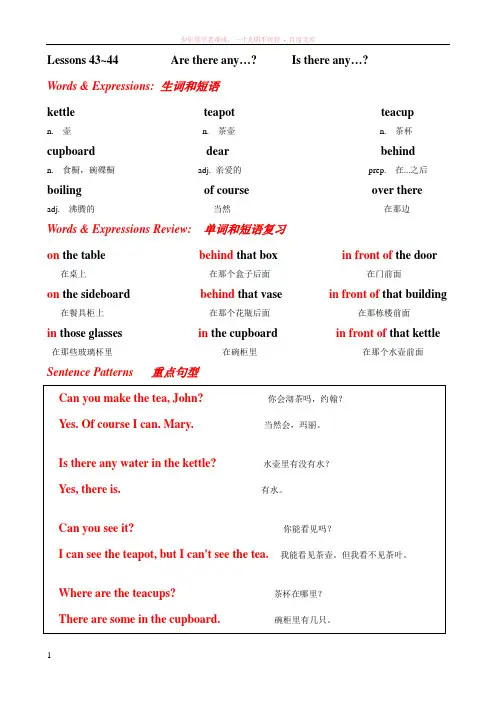
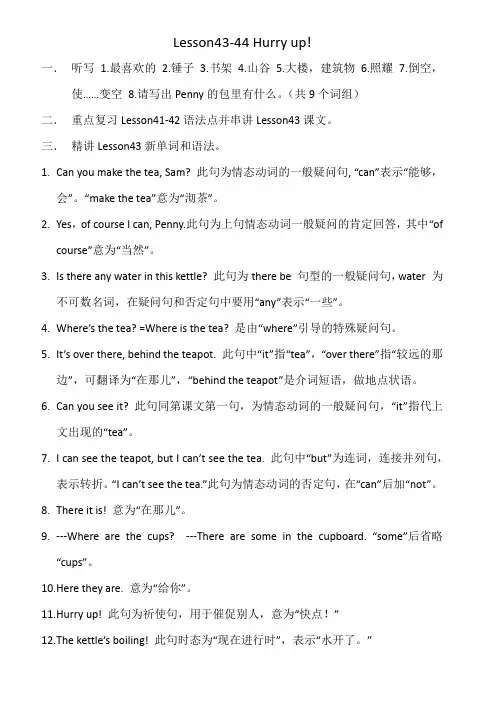
Lesson43-44 Hurry up!一.听写1.最喜欢的2.锤子3.书架4.山谷5.大楼,建筑物6.照耀7.倒空,使……变空8.请写出Penny的包里有什么。
(共9个词组)二.重点复习Lesson41-42语法点并串讲Lesson43课文。
三.精讲Lesson43新单词和语法。
1.Can you make the tea, Sam? 此句为情态动词的一般疑问句, “can”表示“能够,会”。
“make the tea”意为“沏茶”。
2.Yes,of course I can, Penny.此句为上句情态动词一般疑问的肯定回答,其中“ofcourse”意为“当然”。
3.Is there any water in this kettle? 此句为there be 句型的一般疑问句,water 为不可数名词,在疑问句和否定句中要用“any”表示“一些”。
4.Where’s the tea? =Where is the tea? 是由“where”引导的特殊疑问句。
5.It’s over there, behind the teapot. 此句中“it”指“tea”,“over there”指“较远的那边”,可翻译为“在那儿”,“behind the teapot”是介词短语,做地点状语。
6.Can you see it? 此句同第课文第一句,为情态动词的一般疑问句,“it”指代上文出现的“tea”。
7.I can see the teapot, but I can’t see the tea. 此句中“but”为连词,连接并列句,表示转折。
“I can’t see the tea.”此句为情态动词的否定句,在“can”后加“not”。
8.There it is! 意为“在那儿”。
9.---Where are the cups? ---There are some in the cupboard. “some”后省略“cups”。
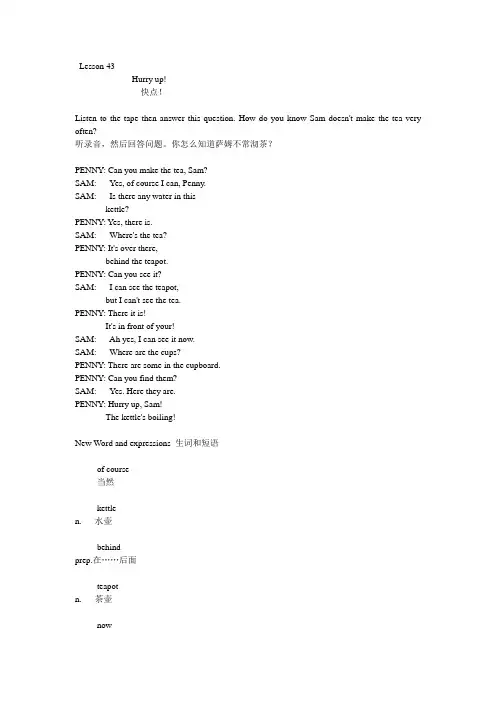
Lesson 43Hurry up!快点!Listen to the tape then answer this question. How do you know Sam doesn't make the tea very often?听录音,然后回答问题。
你怎么知道萨姆不常沏茶?PENNY: Can you make the tea, Sam?SAM: Yes, of course I can, Penny.SAM: Is there any water in thiskettle?PENNY: Yes, there is.SAM: Where's the tea?PENNY: It's over there,behind the teapot.PENNY: Can you see it?SAM: I can see the teapot,but I can't see the tea.PENNY: There it is!It's in front of your!SAM: Ah yes, I can see it now.SAM: Where are the cups?PENNY: There are some in the cupboard.PENNY: Can you find them?SAM: Yes. Here they are.PENNY: Hurry up, Sam!The kettle's boiling!New Word and expressions 生词和短语of course当然kettlen. 水壶behindprep.在……后面teapotn. 茶壶nowadv. 现在,此刻findv. 找到boilv. 沸腾,开参考译文彭妮:你会沏茶吗,萨姆?萨姆:会的,我当然会,彭妮。
萨姆:这水壶里有水吗?彭妮:有水。
萨姆:茶叶在哪儿?彭妮:就在那儿,茶壶后面。
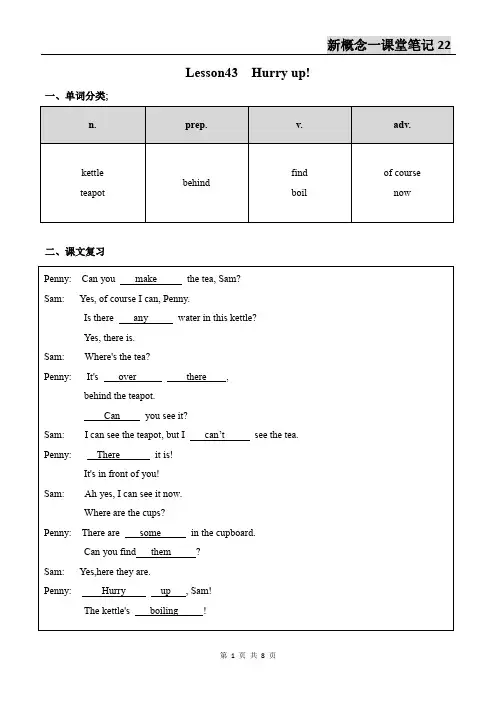

⼀、重要句型或语法 1、情态动词:can 本⾝有⼀定的词义,表⽰语⽓的单词。
但是不能独⽴作谓语,只能和动词原形⼀起构成谓语。
情态动词⽤在⾏为动词前,表⽰说话⼈对这⼀动作或状态的看法或主观设想,如:He can dance./ He can't dance./ Can he dance? Yes, he can. 2、some与any的⽤法:与there be的连⽤ Is there any bread here? Yes, there is. There's some on the table. ⼆、课⽂主要语⾔点 Can you make the tea? make的⽤法可以做回顾拓展,如:make a cake, make coffee, make tea, make the bed等。
Yes, of course I can, Penny. of course相当于第41课中的certainly,表⽰“当然,肯定”。
Is there any water in this kettle? 注意kettle(⽔壶,⽤于烧⽔)和下⽂出现的teapot(茶壶,⽤于泡茶)的区别。
可从合成法⾓度解释teapot,因为它是由tea+pot构成的。
It's over there, behind the teapot. over there表⽰“在那边”,⽤来表⽰离说话者较远的地⽅。
如果较近,可以说“It's right here.”。
behind,可以对⽐复习⼀下in front of和in the front of。
There it is! 表⽰“就在那⼉”,⽤来指出远处的事物。
如果要近指,应该⽤:Here it is! 两者的复数形式分别为:There they are! / Here they are! Can you find them? 注意区分find和look for。
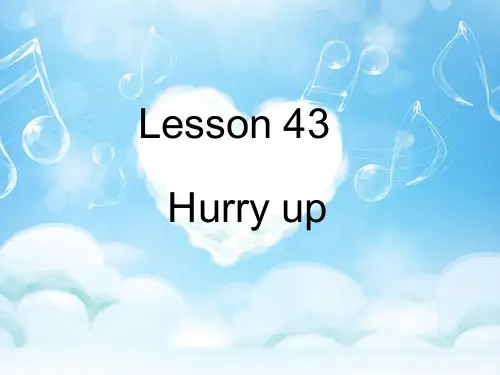
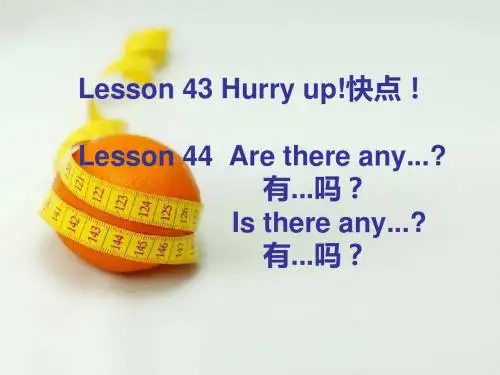
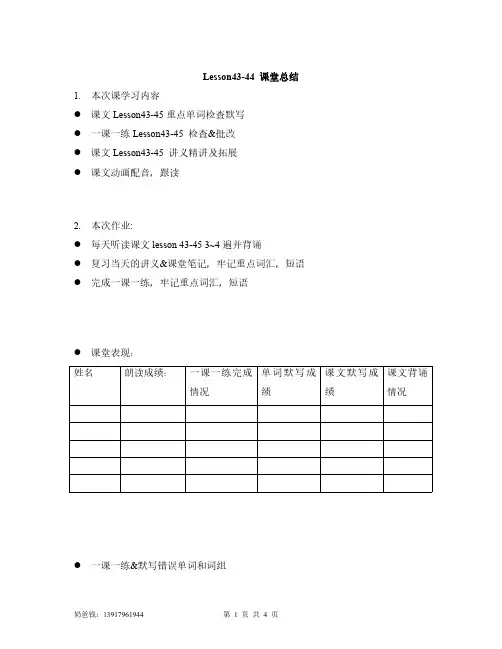
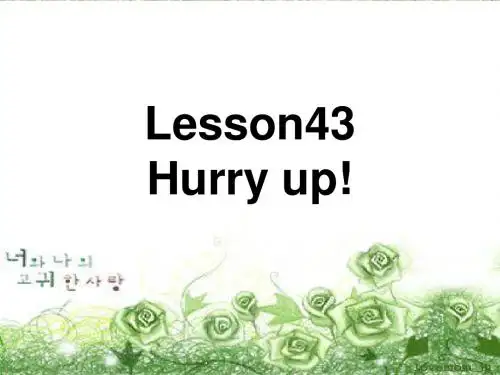
新概念英语第一册习惯用语大全:Lesson 43-44Lesson 43~441.behind prep.在…后面,在…之后,迟于… adv.在…后面,落后behind schedule 耽误;晚点(be delayed; train/or plane arrives late)例句:1.The nurses and doctors are not friendly andeverything seems to be running behind the schedule.护士和医生态度都不太友好,似乎每一件事都要耽误。
2.The 9:30 train seems to be behind schedule.9:30的火车似乎又晚点了。
behind the time(s) 落后于时代A:Boy, how quickly technology changes. So many people have a computer in their homes nowdays.A:天哪,技术变化可真大。
现在很多人家里都有电脑了。
B:I know. I feel so behind the time.B:我理解你的意思。
我觉得我落伍了。
2.can aux./v. 能,会,能够;可能 n.罐头can help 能够避免例句:George will not enroll in that course if he can help it.如果能避免的话,乔治就不会选那门课了。
Can you wire him? 你能给他发个电报吗?A:Dr.Richards wants you to confirm his appointment on the28th in the morning.A:理查兹博士希望你能确认一下28日上午的约会。
B:That's OK. Can you wire him?B:好,你能给他发个电报吗?3.find vt.1.找到,发现2.发觉,感到find (get) a bargain 买便宜货(buy sth. which is really cheap)A:John told me he had got a second-hand car, do you know how much he paid for it?A:约翰告诉我他买到一辆二手车,你知道他花了多少钱吗?B:Well, he said he paid 800 dollars for it. I think he got a real bargain.B:嗯,他说他花了800美元,我认为他买到了便宜货。
新概念英语第一册第43-44课:Hurry up!Lesson 43 Hurry up!快点!Listen to the tape then answer this question.How do you know Sam doesn't make the tea very often?听录音,然后回答问题。
你怎么知道萨姆不常沏茶?Can you make the tea, Sam?彭妮:你会沏茶吗,萨姆?Yes, of course I can, Penny.萨姆:会的,我当然会,彭妮。
Is there any water in this kettle?萨姆:这水壶里有水吗?Yes, there is.彭妮:有水。
Where’s the tea?萨姆:茶叶在哪儿?It’s over there, behind the teapot.彭妮:就在那儿,茶壶后面。
Can you see it?彭妮:你看见了吗?I can see the teapot, but I can’t see the tea.萨姆:茶壶我看见了,但茶叶没看到。
There it is!It’s in front of you. 彭妮:那不是么!就在你眼前。
Ah yes, I can see it now.萨姆:噢,是啊,我现在看到了。
Where are the cups?萨姆:茶杯在哪儿呢?There are some in the cupboard.彭妮:碗橱里有几只。
Can you find them?彭妮:你找得到吗?Yes. Here they are.萨姆:找得到。
就在这儿呢。
Hurry up, Sam.The kettle’s boiling. 彭妮:快,萨姆。
水开了!New Word and expressions生词和短语of course当然kettlen. 水壶behindprep.在……后面teapotn. 茶壶nowadv. 现在,此刻findv. 找到boilv. 沸腾,开Notes on the text课文注释1 make the tea 沏茶。
新概念英语课堂笔记第一册 Lesson 43-44【译文】你能沏茶吗 ,萨姆?【用法】本句是情态动词can的一般疑问句形式。
make the tea 沏茶 ,动词make可以和许多名词组成固定搭配。
例如:make a fire 生火 / make the bed 铺床Yes, of course I can.【译文】是的 ,我当然能。
【用法】of course“当然〞 ,这个短语也可以独立使用。
例如:— Could you help me? 你能帮我一下吗?— Of course. 当然了。
其同义表达有:Sure. / Certainly.It's over there.【译文】就在那边。
【用法】over there“在那边〞 ,指较远的地方。
其对应词组为:over here“在这里〞。
There it is!【译文】在那儿呢!【用法】There it is! 与之前学的Here it is! 相对应 ,本句所指的东西距离较远。
后文中出现的 Here they are!“他们在这儿呢!〞是复数形式 ,对应句型为There they are!“他们在那儿呢!〞There are some in the cupboard.【译文】碗橱里有几只。
【用法】some 在本句中是代词 ,代替的some cups ,以防止重复。
Hurry up, Sam! The kettle’s boiling!【译文】快 ,萨姆。
水开了!【用法】Hurry up! “快点!〞 ,用在祈使句中用来催促某人。
类似的表达还有:Come on! / Be quick!The kettle’s boiling! 是现在进行时 ,表示水正在沸腾。
【介绍】can是英语中最常用的几个情态助动词之一 ,它本身不表示动作 ,只表示体力或脑力方面的能力或客观可能等 ,还可以表示“请求〞和“允许〞。
它必须与其他动词原形连用 ,本身没有人称和数的变化。
Lessons 43~44 Are there any…? Is there any…?Words & Expressions: 生词和短语kettle teapot teacupn. 壶n. 茶壶n. 茶杯cupboard dear behindn. 食橱,碗碟橱adj. 亲爱的prep. 在...之后boiling of course over there adj. 沸腾的当然在那边Words & Expressions Review: 单词和短语复习on the table behind that box in front of the door 在桌上在那个盒子后面在门前面on the sideboard behind that vase in front of that building 在餐具柜上在那个花瓶后面在那栋楼前面in those glasses in the cupboard in front of that kettle 在那些玻璃杯里在碗柜里在那个水壶前面Sentence Patterns 重点句型Can you make the tea, John? 你会沏茶吗,约翰?Yes. Of course I can. Mary. 当然会,玛丽。
Is there any water in the kettle? 水壶里有没有水?Yes, there is. 有水。
Can you see it?你能看见吗?I can see the teapot, but I can't see the tea. 我能看见茶壶。
但我看不见茶叶。
Where are the teacups? 茶杯在哪里?There are some in the cupboard. 碗柜里有几只。
Class Practice 课堂过手练习Sentence Pattern Drilling:句型演练Can you make the tea, John? 你会沏茶吗,约翰?Yes. Of course I can. Mary.当然会,玛丽。
新概念英语第1册Lesson43~48语法及单词解析新概念英语第1册Lesson43~44语法及单词解析语法 Grammar in usecancan是英语中最常用的几个情态助动词之一,它本身不表示动作,只表示体力或脑力方面的水平或客观可能等。
它必须与其他动词连用,本身没有性和数的变化。
如:I can see some coffee on the table.我能看到桌子上的一些咖啡。
Can Sam read this book?萨姆看得懂这本书吗?can的否定形式为can not, cannot或can't(省略式):I can't see any coffee.我看不见什么咖啡。
He can't find the cups.他找不到杯子。
词汇学习 Word study1.find v.(1)找到;寻得:It is most important to find a suitable person for the job.找到一位适合做这项工作的人是至关重要的。
Where are the cups? I can't find them.杯子放在哪儿?我找不到它们。
(2)找出;查明:Shall we ever find an answer to the tough problem ?我们能找出解决这个难题的办法吗?It is found that 70%of college students have part-time jobs.已查明,有70%的大学生做兼职工作。
2 .boil v .(1)开,滚;沸腾:When water boils it changes into steam水沸腾时会变成蒸气。
(2)(海等)翻腾;汹涌:The stormy sea is boiling.暴风雨中的大海汹涌起伏。
(3)(人、感情等)激动;发怒:Seeing the national flag made me boil看着国旗,我心潮澎湃。
新概念英语第一册第43-44课重点语法
一、重要句型或语法
1、情态动词:can
本身有一定的词义,表示语气的单词。
但是不能独立作谓语,只能和动词原形一起构成谓语。
情态动词用在行为动词前,表示说话人
对这个动作或状态的看法或主观设想,如:He can dance./ He can't dance./ Can he dance? Yes, he can.
2、some与any的用法:与there be的连用
Is there any bread here? Yes, there is. There's some on the table.
二、课文主要语言点
Can you make the tea? make的用法能够做回顾拓展,如:make a cake, make coffee, make tea, make the bed等。
Yes, of course I can, Penny. of course相当于第41课中的certainly,表示“当然,肯定”。
Is there any water in this kettle? 注意kettle(水壶,用于烧水)和下文出现的teapot(茶壶,用于泡茶)的区别。
可从合成法角度解释teapot,因为它是由tea+pot构成的。
It's over there, behind the teapot. over there表示“在那边”,用来表示离说话者较远的地方。
如果较近,能够说“It's
right here.”。
behind,能够对比复习一下in front of和in the front of。
There it is! 表示“就在那儿”,用来指出远处的事物。
如果
要近指,应该用:Here it is! 两者的复数形式分别为:There they are! / Here they are!
Can you find them? 注意区分find和look for。
Hurry up, Sam! hurry表示“匆忙”。
hurry up表示“快点,赶紧”。
The kettle's boiling! boil表示“沸腾,烧开”,注意区分boiling water(正在沸腾的水)和boiled water(开水)。
三、双课补充内容
1、操练句型:Is/Are there any...?
2、名词的复数:词尾加es的情况,以及以-f/fe结尾的情况,第88页练习A
3、数字:整十和整百的表达。